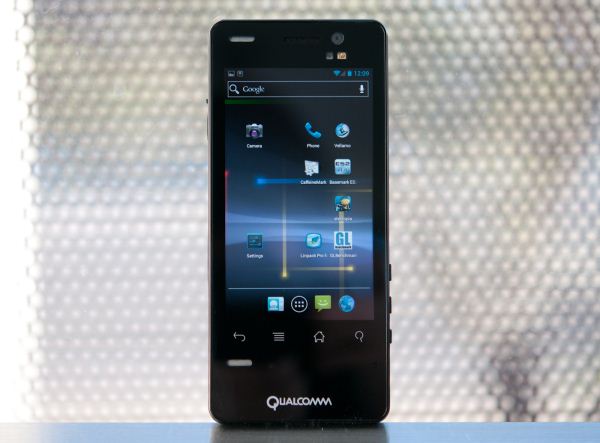Qualcomm Snapdragon S4 (Krait) Performance Preview - 1.5 GHz MSM8960 MDP and Adreno 225 Benchmarks
by Brian Klug & Anand Lal Shimpi on February 21, 2012 3:01 AM EST- Posted in
- Smartphones
- Snapdragon
- Qualcomm
- Adreno
- Krait
- Mobile
Final Words
It goes without saying that MSM8960 is a hugely important SoC release for Qualcomm. It's the first release with Qualcomm's new Krait CPU architecture, an entirely new cellular baseband with support for nearly every air interface, and is manufactured on TSMC's 28nm process. It says something that we're able to hold 28nm TSMC silicon in our hands in the form of the MDP, and it's only a matter of time before we start seeing Krait show up in devices in 2012.
We've gone over basically all of the benchmarks available to us on Android right now, and yet subjective performance impressions are still valuable. The MDP8960 is the absolute fastest we've seen Ice Cream Sandwich thus far - the UI is absolutely butter smooth everywhere, and web browsing in either Chrome or the stock Android Browser is also the smoothest we've seen it. There's no stutter bringing up the application switcher, or taking screenshots, two places that 4.0.3 still drops frames on the Galaxy Nexus.
Krait offers another generational leap in mobile SoC performance. The range of impact depends entirely on the workload but it's safe to say that it's noticeable. The GPU side of the equation has been improved tremendously as well, although that's mostly a function of 28nm enabling a very high clock speed for Qualcomm's Adreno 225. We are eager to see what the Adreno 3xx GPUs that will pair up with future Krait SoCs can do.
The big unknowns today are power consumption and the performance of shipping devices. While we were able to provide power numbers using Qualcomm's handy Trepn tool, we couldn't produce a reference point on older silicon. The move to 28nm and a second generation of cellular basebands has generally been heralded as being the answer to our battery life issues, particularly with LTE. It remains to be seen just how much of an improvement we'll see there. Knowing how much power MSM8960's cellular architecture uses is especially relevant when you consider that MDM9615 includes the exact same modem as MSM8960.
These initial results look extremely promising, however. Krait based devices should begin shipping sometime next quarter, the wait is almost over.











86 Comments
View All Comments
metafor - Tuesday, February 21, 2012 - link
It's Sense. If you look at some of the phones with a less bloated version of Android (like the Xiaomi phone used in the Vellamo benchmark article that runs the same processor as the Rezound but with MIUI), they score pretty close to the MDP scores.Wishmaster89 - Tuesday, February 21, 2012 - link
That is why I will never buy device that bares the mark 'with HTC Sense'.They went one step too far with their customisations when they impacted performance of the device.
monoik - Tuesday, February 21, 2012 - link
Did you make your tests on Gingerbread SGS2? I'm getting very different results on Ice Cream Sandwich Cyanogen Alpha:For worse:
Linpack single 47.257 MFLOPS
Linpack multi 71.987 MFLOPS
For better:
BrowserMark 105937
Vellamo 1596
SunSpider-0.9.1 1762.2ms
non-cached anandtech.com about 4,5 seconds from touching "go" to the progressbar disappearing.
cached anandtech.com less than 2 seconds.
Stock browser. No overclocking. GT-I9100 Exynos version.
Kaboose - Tuesday, February 21, 2012 - link
I am going to assume the latest OFFICIAL OS released by samsung Anandtech is not in the business of benchmarking every different ROM or OS on every phone. You would most probably be getting different results running ICS Cyanogen. As far as I know ICS is only official on the Nexus.monoik - Tuesday, February 21, 2012 - link
I assume you're right, so we're comparing apples and oranges here. No real value there, don't you think?rahvin - Tuesday, February 21, 2012 - link
Cyanogen is typically crippled by the fact that they are restricted to the open source versions. Especially in early release they don't have access to many of the customizations and binary code in release versions let alone per-release.It's my experience that Cyanogen doesn't even come close to release performance or power use until about a year later. This is because it takes the manufacturers about 6 months to post their kernel source then another 6 months to port and modify for the cyanogen system.
So comparing a cyanogen alpha mod to a developer preview isn't even relevant, as was said.
tomhoward - Tuesday, February 21, 2012 - link
There original SGS2 results were incorrect in the S2 vs 4S post a while back. There was a pretty big flame war in the comments from people with stock phones getting around 2000ms in Sunspider but Anandtech just ignored them.B3an - Tuesday, February 21, 2012 - link
@Brain or Anand...Do you think that Win 8 tablets using ARM SoC's will likely have a SoC based on many of the components inside Krait? I know there will have be certain changes for WOA but the CPU and possibly the GPU (now that it supports Direct3D 9_3) will be used for these tablets?
And the same goes for ARM's A15, will WOA likely be running on SoC's based on that too?
kyuu - Tuesday, February 21, 2012 - link
If I can get this SoC in a Lumia-ish Windows 8 phone with a decent screen and removable micro-SD storage, whoever makes that phone will have my money.kyuu - Tuesday, February 21, 2012 - link
I mean Windows *Phone* 8 phone, of course.